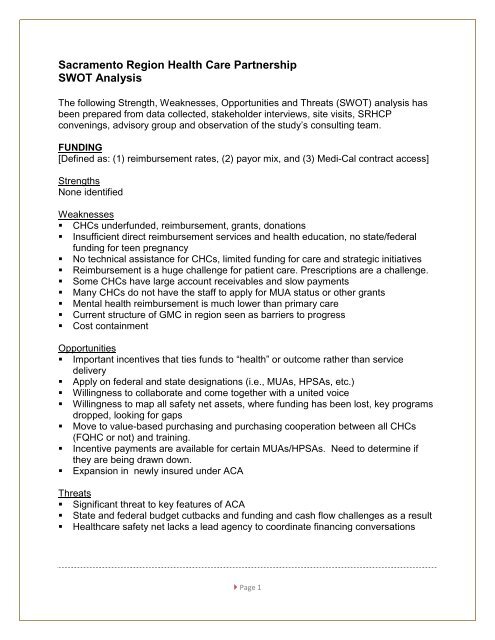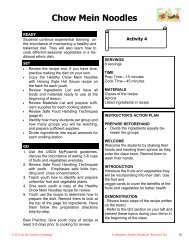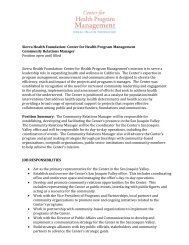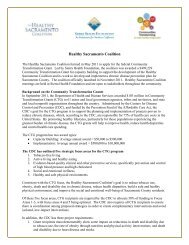Sacramento Region Health Care Partnership SWOT Analysis
Sacramento Region Health Care Partnership SWOT Analysis
Sacramento Region Health Care Partnership SWOT Analysis
Create successful ePaper yourself
Turn your PDF publications into a flip-book with our unique Google optimized e-Paper software.
COLLABORATION[Defined as: (1) cooperation among CHCs, hospitals and clinicians (2) coordinatedstrategies from financing sources (i.e., county indigent care, Medi-Cal managed care,health systems, etc.) and (3) cooperative opportunities resulting in better care, lowercosts and more leveraged coverage of care]Strengths• Some FQHCs meet and share regularly• Network of clinic consortiums (i.e., Central Valley Cooperative, Capitol Community<strong>Health</strong> Network, Redwood Community <strong>Health</strong> Coalition, etc)• Access El Dorado, Placer Collaborative Network, Future of the Safety Net YoloCounty,• Supportive local medical society• Supportive health systems• There are other good collaboration models in region that can be learn from (i.e.,hospital and clinic collaboratives)Weakness• Very competitive health care market leads to lower collaboration and sharing ofresources - discharging patient is like “walking the plank”• No clear collective community clinic voice or vision• Lack of culture of sharing• Siloes mentality• Less than optimal engagement by health care stakeholdersOpportunities• Convening health care stakeholders for knowledge sharing• Expand collaboration outside HC (healthcare) arena to include business community.• Sighting of HC facilities are not by transportation or the transportation hours do notcorrespond with the facility.• Collective desire to identify and implement strategies to reduce unnecessary EDvisits• Willingness to establish new partnerships and shared visions between hospitals andCHCs• Shared services/group purchasingThreats• Proprietary view of information• Sharing may be perceived as putting at risk some current collaborative• <strong>Health</strong>care safety net lacks a lead agency strong enough to coordinate and integratedifferent interest. Page 2
EXPANSION, RETENTION OF WORKFORCE[Defined as: (1) workforce for staffing CHCs, (2) strategies that are within the control oftime and resources for this project and (3) cooperative opportunities which can beaccomplished with limited resources]Strengths• Great training capabilities in this region capable of meeting a wide range of needs(i.e., physician, nurse practitioner, pharmacy, medical assistants, etc.) and thepotential to bring some these experts to the CHC arena• Lessons learned from application to CMMI proposal prep re: allied health, educationand community health workersWeakness• Wide background for clinicians, expand regulations• Retiring clinical workforce is going to mean a shortage• Clinicians working with minority groups/cultural competency• UC Davis stepping away from primary care training• Little regional workforce training coordinationOpportunities• Coordinate training resources in the region• HRSA pushing pharmaceutical, use school of pharmacy to assist CHCs with meds• Ability to leverage training resources at low cost• Telemedicine presence is strong for leveraging skilled practitionersThreats• Significant primary care and specialty physician care shortage• Need to increase workforce by 2014• No residency program at the CHCs• Potential challenge to future nursing capacity• Lack of significant workforce alternatives (i.e., nurse practitioners, physicianassistants) Page 3
PRIMARY CARE SAFETY NET & SPECIALTY CARE[Defined as: (1) primary care physicians and providers (NPs and Pas) in sufficientcapacity to meet or exceed safety net demand, (2) strategies for specialty carefullyleveraged through best and promising practices (3) access to both categories in a timelymanner is achieved]Strengths• CHCs have the ability to employ primary care providers• Small but significant number of private practitioners willing to see safety-net patients• Some CHCs have deployed best practices to obtain limited specialty care access• Many national models for achieving “leveraged” specialty care coverageWeakness• Behavioral health is also a challenge particularly for hospital care. Need to improveefficiency of care coordination between systems• Low number of specialists in the region. Reimbursement is low or nonexistent fortheir services• Gap between optimal and actual visit, need to do process improvement region wide• <strong>Care</strong> plans for defining appropriate specialty care services and screening for thoseservices are not universally applied by CHCs throughout the region• GMC definition of network and geographical assignments of patients has the impactof restricting access• GMC has a “published” network of specialty-care physicians• The region is not prepared for the concept of “medical home”Opportunities• Possibility of virtual “homes”, creative thinking, and telehealth• Include health care prevention• Telehealth can address some specialty care accessThreats• Limited actual or practical coverage• Much competition from health groups and health systems for the retention of primarycare practitioners• Productivity from a regional sense in terms of encounters per provider is lower thanthe statewide average Page 4
CARE COORDINATON[Defined as: (1) interface between care givers (i.e., CHCs, hospitals, etc.) is optimized,(2) strategies for case management and chronic disease is fully embraced betweenthese entities and (3) metrics in place to measure outcomes and to adjust performance]Strengths• Hospitals and CHC “T 3 ” program• Grant funding is available and has been utilized to a certain extent for this issue inthe regionWeakness• Does not exist to any significant degree• Much in the way of episodic care and thus not the desired medical home model• Extensive overuse of ED resources by those in the safety net that do not need touse that service and when they do receive episodic careOpportunities• Community Based <strong>Care</strong> Transition Program – CMS, prevent readmits w/in 30-days.• Accountable <strong>Care</strong> Organizations• Reduce unnecessary ED visits through education, promotores and partnering withfaith based/community organizationsThreats• Destined to a high-cost, less-than-ideal outcomes for health care• Not properly using all the extensive capabilities that need coordination in the regionIT/COMMUNICATION INTEGRATION[Defined as: (1) IT capability designed to inform and coordinate care amongst allregional care givers and other key providers, (2) IT systems that can access best andpromising practices (i.e., CHCs, Stanford and Kaiser care management pathways, etc.)and (3) operational care coordination to assure the best care and case coordinationpractices are optimized]Strengths• All hospitals and most CHCs have made a substantial commitment to IT/EHR• Federal and local support likely available• <strong>Health</strong>y Living Map• Using telehealth in El Dorado County for complex chronic diseases Page 5
Weakness• IT systems that are in place are unique for small community based orgs• No real regional collaboration for interactivity/interoperability not achieved• In real terms: “our EMRs cannot talk to each other”• Big telehealth program (UCD) in region and it is underutilized locally• Telehealth only works if specialists participateOpportunities• Included this in the recent community CMS Innovations grant• Excellent IT development resource (CalHIPSO & Redwood Empire, etc.)• Cloud technology• Expand provider directory on healthy living map to all four counties• Web or mobile technologyThreats• Without full interoperability will not achieve and the “vision” for EMRs will not beachievable identified• Like care will continue to be fragmented, unnecessarily repetitive and duplicativeand the “medical home” model will not be fully achievedBUILDING CAPACITY[Defined as: sufficient physical, workforce and financial resources to meet all the needsof the safety net into the future particularly with regard to ACA]Strengths• Network of CHCs with nearly half that are FQHCs or look-alikes• Engaged stakeholder group• Hospitals that are supportive and are key funding sources to date• Significant building and capital expansion plans in development for the CHC• Many CHCs have additional physical capacityWeakness• There is a shortage of specialty care physicians• The data shows capacity will be full 2014• Sources of care are not always coordinated as to the selected sites for CHCs• Competition between CHCs• Silo mentality Page 6
Opportunities• Identify building space/facilities to expand operations• Funding for remodeling and renovations for building space/facilities• Coordination with community clinics initiative• ACA capacity grantsThreats• Funding and expertise to plan expansion missing• Silo mentality, no coordination in planning• Not hitting the targeted need would be a critical failure of the regionLEADERSHIP[Defined as: key organization(s) or person(s) that will facilitate goal setting, measures ofsuccess, recognition and adoption of best practices and funding sources that will bringmentoring and technical support to the region to assure the goals of the plannedstrategic plan and beyond are met and exceeded for the primary care safety net.]Strengths• Network of CHC consortiums in place• Leadership shown by the Foundations that have underwritten this initiative• Hospitals that are supportive• Engaged stakeholder group• Broad endorsement by most stakeholders during this project that this level ofleadership is neededWeakness• Leadership as defined does not currently exist• No current entity has been identified as fulfilling this role• Current silo mentality makes this goal a challenge• Many missed opportunities (i.e., funding, care coordination, IT, best practicerecognition and adoption, etc.)• Some funding sources “sprinkle” their funding without benefit of a community-basedconsensus of prioritiesOpportunities• No existing structure that would distract from a “zero-base” start to this topic• Tremendous potential yield to meet all goals with an effective leadership structure• Significant acceleration of capacity building goals could be achieved with suchleadership Page 7
Threats• Perceived risk of proprietary methods and data being exposed• Competitive nature of some provider entities• Silo mentality, no coordination within key areas (i.e., planning, sharing practices,shared risk, pilot studies, etc.)• Without an effective leadership structure the goals of this study will not be achieved• The current system’s fragmentation is destined to continue Page 8













